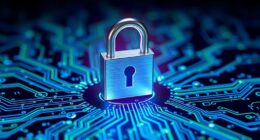To keep your home Wi-Fi safe from hackers, change default router passwords, use WPA2/WPA3 encryption, update router firmware regularly, disable remote access, and place the router centrally. Hide your network's SSID, create a strong Wi-Fi password, and set up firewall protection. Establish a guest network with limited access and update security regularly. Combing these steps will provide a strong defense against cyber threats.
Key Takeaways
- Change default router passwords to unique, strong ones.
- Enable WPA2/WPA3 encryption for secure data transmission.
- Update router firmware regularly to patch vulnerabilities.
- Disable remote router access to prevent unauthorized control.
- Conceal SSID broadcast and use long, strong Wi-Fi passwords.
Change Default Router Passwords
Changing the default passwords of your router is a crucial step in safeguarding your home Wi-Fi network from potential security threats. Default passwords provided by router manufacturers are often known to hackers, making it easier for them to gain unauthorized access to your network.
To secure your home network, it is essential to set a unique and strong password that is not easily guessable. Using the default password increases the risk of security breaches, as hackers actively target such vulnerabilities.
By changing the default router password to a strong and unique one, you greatly reduce the chances of unauthorized access and potential cyber threats. This simple yet effective measure enhances the overall security of your home Wi-Fi network, ensuring that your personal data and online activities remain safe from malicious individuals seeking to exploit default settings.
Take control of your network security by securing your router with a strong password tailored to your home's protection.
Enable Network Encryption

To strengthen your home Wi-Fi security, it is vital to enable network encryption. By utilizing WPA2 or WPA3 encryption, you can safeguard your data transmissions from potential hackers. Encryption serves as an essential defense mechanism, preventing unauthorized access and protecting sensitive information like passwords and financial data.
Strong Password Protection
By enabling network encryption such as WPA2 or WPA3, you can establish a vital layer of security for your home Wi-Fi network against potential hackers. To further enhance the security of your network, follow these guidelines for strong password protection:
- Use a unique and strong password containing a mix of letters, numbers, and symbols to prevent unauthorized access.
- Avoid default passwords provided by router manufacturers as they are easy targets for hackers seeking to breach your network.
- Regularly change your Wi-Fi password to reduce the risk of cyber threats and unauthorized breaches.
Network encryption plays an essential role in preventing data interception, safeguarding your personal information.
Strengthen your network security by combining strong passwords with reliable encryption methods like WPA2 or WPA3 to fortify your defenses against potential cyber threats and breaches.
WPA3 Security Standard
Implementing the WPA3 security standard on your home Wi-Fi network is essential for enhancing network encryption and safeguarding against potential cyber threats. WPA3, the latest Wi-Fi security standard, provides stronger protection against brute-force attacks and unauthorized access by offering individualized data encryption for each device connected to the network. This enhanced security feature guarantees that even if one device is compromised, the others remain protected. Additionally, WPA3 improves Wi-Fi security by safeguarding against offline dictionary attacks, where hackers attempt to crack passwords using precomputed lists of possible passwords.
To better understand the benefits of enabling WPA3 encryption on your network, take a look at the table below:
| WPA3 Security Features | Benefits |
|---|---|
| Individualized Encryption | Enhanced protection against unauthorized access |
| Protection from Brute-Force | Stronger defense against brute-force attacks |
| Defense Against Dictionary | Safeguarding network from offline dictionary attacks |
Update Router Firmware Regularly

Regularly updating your router's firmware is essential in safeguarding your home WiFi network from potential security threats. By keeping your firmware up to date, you guarantee that your router receives the latest security patches to defend against vulnerabilities.
To update your router's firmware, check the manufacturer's website or access the admin interface for instructions on how to perform the update.
Firmware Security Importance
Maintaining the security of your home WiFi network requires prioritizing the importance of updating your router firmware regularly. Failure to update router firmware exposes your network to security vulnerabilities and cyber threats.
Here are key points to keep in mind:
- Regular firmware updates patch security vulnerabilities.
- Outdated firmware can lead to unauthorized access.
- Firmware updates enhance network defenses.
- Hackers target known vulnerabilities in outdated firmware.
- Automatic updates guarantee timely security enhancements without manual intervention.
Updating Procedure Steps
To guarantee the security of your home WiFi network, it is essential to prioritize updating your router firmware regularly. Router firmware serves as the operating system of your router, and keeping it up to date is vital in safeguarding your network against security breaches, vulnerabilities, cyber attacks, and unauthorized access.
Manufacturers frequently release firmware updates to address known security issues, fix bugs, and enhance overall performance. Failure to update your router firmware exposes your network to potential risks, compromising both security and privacy.
To make sure your router remains secure, it is recommended to set up automatic updates if available. Alternatively, regularly checking for firmware updates manually is advised. By staying proactive in updating your router firmware, you can significantly reduce the chances of falling victim to cyber threats and unauthorized intrusions.
Disable Remote Router Access

Disabling remote router access is an essential step in safeguarding your home Wi-Fi network against potential hacking threats.
Hackers often target remote access features to gain control over routers, making it crucial to take preventive measures. By turning off remote access, you prevent unauthorized users from remotely controlling your router, effectively limiting the entry points for cyber threats.
This security measure plays a vital role in protecting your network from potential hacking attempts.
- Prevents unauthorized users from remotely controlling your router.
- Protects your network from potential hacking attempts.
- Hackers often target remote access features to gain control over routers.
- Turning off remote access limits the entry points for cyber threats.
- Ensures your home Wi-Fi network is secure by disabling remote router access.
Place Router Centrally

For essential Wi-Fi coverage and enhanced network performance, strategically placing your router centrally within your home is key. Router placement plays a critical role in ensuring ideal signal coverage and reducing dead zones in your living space. By positioning the router in a central location, you can distribute the Wi-Fi signal more evenly, enhancing network performance and minimizing signal interference.
When determining the best placement for your router, avoid positioning it near walls, floors, or metal objects that can obstruct the transmission of signals. These physical barriers can weaken the Wi-Fi signal, leading to reduced coverage and potential connectivity issues. By placing the router centrally and away from such obstructions, you can enhance both the reach and quality of your Wi-Fi network.
In addition to improving signal coverage and network performance, central router placement can also enhance Wi-Fi security by minimizing signal leakage outside your home. Key placement is vital to achieving a reliable and secure Wi-Fi connection throughout your living space.
Hide Network SSID

Enhancing the security of your home Wi-Fi network involves concealing the network SSID to prevent unauthorized access. Hiding your network SSID prevents it from being broadcasted to nearby users, making your Wi-Fi network invisible to unauthorized users searching for available networks.
By disabling SSID broadcast, you add an extra layer of protection against potential hackers. This security measure is an effective way to prevent casual users from connecting to your network without permission, ensuring the privacy and security of your home Wi-Fi network.
- Conceal your network SSID to prevent it from being visible to unauthorized users.
- Make your Wi-Fi network invisible to nearby individuals searching for available networks.
- Add an extra layer of protection by disabling SSID broadcast.
- Prevent potential hackers from easily identifying and accessing your network.
- Safeguard the privacy and security of your home Wi-Fi network with this security measure.
Use Strong Wi-Fi Password

To strengthen the security of your home Wi-Fi network, one essential step is to make sure you use a strong Wi-Fi password.
A strong Wi-Fi password should be at least 20 characters long and include a combination of numbers, letters, and special characters to enhance complexity.
It is important to avoid using common words, phrases, or easily predictable patterns to deter hackers from accessing your network.
Regularly changing your Wi-Fi password adds an extra layer of security, preventing unauthorized users from gaining access to your sensitive information.
Implement Firewall Protection

Implementing firewall protection is essential for safeguarding your home Wi-Fi network from potential cyber threats and unauthorized access. Firewalls act as a barrier between your network and potential hackers, filtering out malicious traffic. They monitor incoming and outgoing network traffic, blocking unauthorized access and potential threats.
Firewalls can be hardware-based (built into your router) or software-based (installed on your devices). They are vital for protecting sensitive data and preventing cyber attacks on your home network. Regularly updating and configuring your firewall settings is essential to guarantee top-notch protection against evolving threats.
Set up Guest Wi-Fi Network

When considering additional layers of security for your home Wi-Fi network, establishing a separate guest Wi-Fi network is a prudent measure to isolate guest devices and protect your main network.
By creating a distinct guest Wi-Fi network, you can enhance security by setting a unique SSID and password, preventing unauthorized access. It is crucial to limit the bandwidth and network access permissions for devices connected to the guest network, reducing the risk of potential security breaches.
To maintain a secure environment, regularly update the security settings of your guest network and consider changing the password periodically for added protection. Leveraging the guest network features on your router can simplify the management and monitoring of guest connections, allowing you to guarantee the security of your main network remains intact.
Prioritizing these security measures will fortify your home Wi-Fi network against potential threats and unauthorized access attempts.
Frequently Asked Questions
How Do You Secure Your Home Wi-Fi?
To secure your home Wi-Fi network, it is essential to implement best practices such as changing the SSID, creating a strong password, enabling WPA2 encryption, disabling network name broadcasting, and regularly updating your router's software for enhanced security.
Can Hackers Hack Your Home Wi-Fi?
Hackers possess the ability to infiltrate home Wi-Fi networks, exploiting vulnerabilities in security protocols. The consequences of such breaches can be severe, leading to the unauthorized access of personal data. Safeguarding your network is imperative.
How to Encrypt Home Wi-Fi?
To encrypt your home Wi-Fi, utilize WPA3 or WPA2 encryption protocols. Encryption safeguards data transmission, prevents unauthorized access, and enhances network security. Implementing encryption is an essential step in protecting your home Wi-Fi network from potential hackers.
How Do I Make My Router More Secure?
Enhance your router's security by changing default passwords, enabling encryption protocols, updating firmware, disabling remote management, and hiding your SSID. These measures fortify your network against potential intrusions and safeguard your data effectively.
Conclusion
In a world where our homes are increasingly connected, safeguarding our Wi-Fi networks is essential. By following simple steps such as changing default passwords, enabling encryption, and updating firmware regularly, we can create a secure digital fortress against potential hackers.
Just as we lock our doors to protect our physical space, let us also fortify our virtual boundaries to keep our homes safe from unseen intruders.









